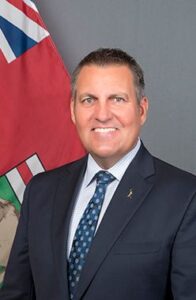
Economic Development Minister Cliff Cullen
To Cliff Cullen, minister responsible for Manitoba Hydro, the change alleviating Manitoba Hydro of some of its debt burden is just the first step toward developing a long-term strategy that needs to include a new energy policy for the province. “The government and Hydro have to come together to create a modern approach to Hydro electric energy and sales,” says the minister, who believes that we need a comprehensive plan going forward.
“Hydro needs policy direction,” he says. Part of that is looking at all the factors that will affect Hydro sales, its budget, and how Manitobans can best use the resource to meet development goals in the coming years.
“For example, we need to look at our external contracts and determine whether we should direct excess power to other jurisdictions to fuel their growth and expansion or if we would be better advised to maintain our resources to build manufacturing and other sales, domestically.”
Based on historic records and looking down the road, we know that fluctuating water levels will affect our productivity in coming years. Water management is critical. “We must think of ways to mitigate the effects of this on both our budget and our supply of power,” he says.
To that end, in May 2021, the Manitoba government invested $1 million in a Water Strategy Fund to support the development and implementation of Manitoba’s provincial water management strategy. Implementation of many of its recommendations might be incorporated in planning for and mitigating future water supply fluctuations that will impact supply and hydro generation and the finances of the utility.
Recently the need for level three power charges in the north has been top of mind, not just to support local populations but to enhance tourism and eventually to supply the transportation industry. For example, Gardewine has been electrifying its local transport vehicles over the past few years and hopes to ultimately convert its long-distance transportation fleet. Last November they added seven new electric vehicles. This is just one example of how quickly the world is adjusting to the new imperative for reduced carbon emissions and Manitoba is well placed to take advantage of this.
“With the integrated Hydro plan that we are developing, we can capitalize on these changes,” says the minister. “That includes a rationalization of the red tape that limits what can be done to market hydro sales – simple things such as the inability of Hydro to wholesale power for resale to others who may be willing to take risks in installing high level charging stations.”
“We need to look at all the options, including variable rate structures that are employed by other provinces.
“All of these changes and strategies are in aid or building a positive future for our province.”
PROVINCIAL GUARANTEE FEE
The Provincial Guarantee Fee (PGF) is an annual fee payable to the Province of Manitoba in exchange for the debt guarantee. Until recently, it was calculated using a rate of 1% multiplied by the applicable outstanding debt at March 31st of the previous fiscal year. (When first established, the fee was 0.125% in 1961 and increasing to 1% in 1991.) On November 23, 2022, the Province of Manitoba announced the reduction of the fee to 0.5% of outstanding debt effective April 1, 2022.
The Provincial Guarantee on Manitoba Hydro’s debt is an essential and fundamental requirement to successfully finance Manitoba Hydro’s capital programs allowing Manitoba Hydro to borrow at rates lower than what Manitoba Hydro could access in the market absent the Provincial guarantee.

